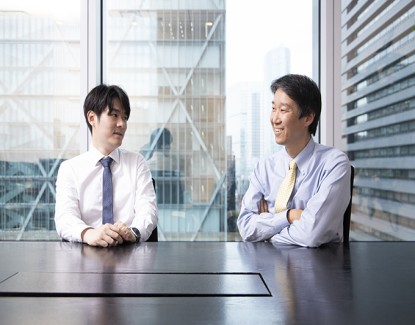Market Commentary and Fund Performance
Masa Takeda of Tokyo-based SPARX Asset Management Co., Ltd., sub-advisor to the Hennessy Japan Fund, shares his insights on the Japanese market and Fund performance.
-
 Masakazu Takeda, CFA, CMAPortfolio Manager
Masakazu Takeda, CFA, CMAPortfolio Manager
Fund Performance Review
In February, the Fund decreased by 4.08% (HJPIX), slightly underperforming its benchmark, the Russell/Nomura Total MarketTM Index, which fell by 3.95% and the Tokyo Stock Price Index (TOPIX), which declined 3.63%.
The month’s positive performers among the Global Industry Classification Standard (GICS) sectors included shares of Financials, while Industrials, Consumer Staples, and Health Care detracted from the Fund’s performance.
Click here for full, standardized Fund performance.
Among the best performers were our investments in Mitsubishi Corporation, the largest trading company in Japan, Tokio Marine Holdings, Inc., the general insurance company with the best underwriting track record in Japan, and ORIX Corporation, Japan’s largest non-bank comprehensive financial services company.
As for the laggards, Recruit Holdings Co., Ltd., Japan’s unique print and online media giant specializing in classified ads as well as providing HR services, Olympus Corporation, the leading company in the medical field such as gastrointestinal endoscopy, which has a 70% share of the world market, and Hoya Corporation, a manufacturer of optical products, were the largest detractors.
This month, among the many companies that announced quarterly earnings results, ORIX released an encouraging set of numbers following disappointing financial performance in H1 FY2022/3 (ending in March 2023). The third quarter consolidated net profit came in at JPY 89.6 billion ($667.6 million), +38.5% year over year (YoY) and +49.6% quarter over quarter (QoQ). Its annualized return on equity (ROE) improved to 8.6% this quarter from 7.4% a quarter ago. Though the current run-rate is below satisfactory level, we are optimistic that the company is on track to meet its mid-term goal of ROE 11.7% by FY2025/3.
ORIX is Japan’s largest non-bank comprehensive financial services company. It was established in 1964 as a leasing company, but subsequently diversified into a broad range of fields including aircraft leasing, property development, asset management, banking, life insurance, private equity, venture capital, renewable energy investment, airport concession, and so on. It also has a global footprint with roughly half of the earnings generated overseas.
Using the growth rate of book value per share (net asset value per share) as a proxy for the growth rate of intrinsic value, ORIX has grown at 7-10% per annum over the last 5- and 10-year periods. During its history since 1964, it has never reported a net loss.* In terms of shareholder return policy, management is committed to a 33% payout ratio, which equates to a dividend yield of about 4% at the current share price. On top of this, management have repeatedly stated that, in the event there are not enough attractive business opportunities to use up available capital, they will return it to the shareholders in the form of share buybacks, and they have been acting on this. In the last three years, the share count has decreased at a rate of 2-3%, which helps the earnings growth rate on a per share basis. At the current valuation of 8 times forward price to equity (P/E) and 0.8 times price to book (P/B) with an ROE of 10%, we believe management is conducting capital allocation in a very rational manner.
ORIX’s sustainable growth rate therefore is in the mid-single digit range. As a shareholder, you get dividend yields of 4% at present with further upside in dividend per share as the business grows, and they can constantly buy back shares if need be, which helps to raise earnings per share. If you add these sources of return, a sustainable shareholder return comes out to 10% plus per annum. This is comparable to our other growth-oriented long-term portfolio holdings, which have higher expected earnings compounded annual growth rate (CAGR) but negligible share buybacks and meager dividend yields.
You might find it surprising that the company is a beneficiary of Japan’s reopening and inbound tourists demand. There are three business lines which management calls “COVID-impacted businesses.” They are 1) Facility operations, 2) Aircraft leasing and 3) Airport concession business. In the facility operations business, ORIX runs mid-to-high end hotel operations (11 hotel properties) across Japan. During the pandemic in FY2022/3, this business posted a net loss of JPY 9 billion ($67.1 million) owing to a sharp drop in occupancy rate. With the reopening of the economy and the reopening of the borders to foreign tourists, customers are now returning at a fast clip. Assuming the business can normalize to pre-COVID profit level of JPY 6 billion ($44.7 million), the profit improvement can be as big as JPY 15 billion ($111.8 million) by FY2025/3.
Under the airport concession business, ORIX owns a 40% stake in Kansai Airport, which in turn, has concession contracts with Kansai International Airport, and two domestic airports (Osaka International Airport and Kobe Airport) in the Kansai region. ORIX recognizes 40% of their net income through equity method, consisting of landing fees, parking charges collected from airlines and profits from retail businesses inside the terminal buildings. This is an attractive business as there is no alternative airport that could displace them in the region. In FY2022/3, this business reported JPY 10 billion ($74.5 million) in net loss amid the pandemic, however the airline passenger numbers have begun to recover quickly following the government’s announcement of the border reopening in early October 2022. The utilization rate was at 40% of pre-COVID levels as at the year end and continues to recover today. Furthermore, Kansai International Airport is scheduled to undergo a capacity expansion plan in the next several years. After the completion of this project, the total capacity is estimated to increase to 40 million passengers from the current 30 million. It is very likely that this business will achieve profits higher than pre-COVID peak of JPY 20 billion ($149.0 million).
Lastly, the aircraft leasing business has also been seeing a strong recovery in earnings since early last year on the back of improving air traffic globally. ORIX manages aircraft leasing services through its wholly-owned subsidiary ORIX Aviation and an affiliate company called Avalon (30% owned). Prior to the pandemic, this business contributed JPY 45 billion ($335.3 million) to the company’s bottom line followed by a temporary small net loss in FY2022/3 due to COVID. Today, it is in a steady recovery trend. It is also encouraging to know that the business was not severely impacted by the Russian / Ukraine war, where many of the global lessors had their leased aircraft confiscated by the Russian government, resulting in heavy losses. The short-term risks are rising interest rates, which causes its funding costs to go up, however, the leasing business, in general, has the ability to pass on the increased costs to the customers later on.
Combining these three businesses, ORIX reported JPY 22 billion ($163.9 million) in net losses in FY2022/3. Management believes that just bringing them back to the pre-COVID profit levels would give them a profit improvement of over JPY 80 billion ($596.1 million), which accounts for the bulk of projected earnings growth of JPY 128 billion ($953.7 million) from FY2022/3 to FY2025/3 according to their mid-term business plan. This calls for 12% CAGR from net profit (NP) 312 billion ($2.3 billion) to NP 440 billion ($3.3 million). Based on the above, the FY2025/3 target seems reasonably achievable to us. Thus, the overall profit is likely to be 40% higher than FY2022/3 accompanied by a higher ROE, which may provide upside to the current valuation multiples as well.
Click here for a full listing of Holdings.
- In this article:
- Japan
- Japan Fund
You might also like
-
 Portfolio Perspective
Portfolio Perspective
Japan Small Cap FundA Focus on Japanese Small-Caps Making Big Corporate Improvements
 Takenari Okumura, CMAPortfolio Manager
Takenari Okumura, CMAPortfolio Manager Tadahiro Fujimura, CFA, CMAPortfolio ManagerRead the Commentary
Tadahiro Fujimura, CFA, CMAPortfolio ManagerRead the CommentaryThe Portfolio Managers discuss their view of the Japanese small-cap corporate landscape amid many shifting factors, including a new Prime Minister, finalized tariff situation, currency volatility, and attractive valuation environment.
-
 Portfolio Perspective
Portfolio Perspective
Japan FundCompelling Japanese Opportunities Amid Attractive Valuations
 Masakazu Takeda, CFA, CMAPortfolio Manager
Masakazu Takeda, CFA, CMAPortfolio Manager Angus Lee, CFAPortfolio ManagerRead the Commentary
Angus Lee, CFAPortfolio ManagerRead the CommentaryThe Hennessy Japan Fund Portfolio Managers highlight the effect of the new Prime Minister on the economy and market and how holdings were affected by the final trade agreement. They also discuss currency volatility, valuations, and the most compelling opportunities as we end 2025.
-
 Investment Idea
Investment IdeaCompelling Valuations in Japan
 Masakazu Takeda, CFA, CMAPortfolio Manager
Masakazu Takeda, CFA, CMAPortfolio Manager Angus Lee, CFAPortfolio Manager
Angus Lee, CFAPortfolio Manager Tadahiro Fujimura, CFA, CMAPortfolio Manager
Tadahiro Fujimura, CFA, CMAPortfolio Manager Takenari Okumura, CMAPortfolio ManagerRead the Investment Idea
Takenari Okumura, CMAPortfolio ManagerRead the Investment IdeaJapanese equities are currently trading at compelling valuation levels compared to other developed equity markets around the world and relative to their own historical averages. We believe the Japanese market deserves a closer look.
